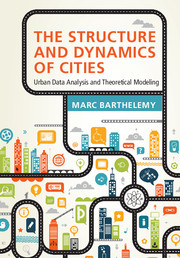Book contents
9 - Toward a new science of cities
Published online by Cambridge University Press: 10 November 2016
Summary
What is our “understanding”?
As we discussed in Chapter 1, “understanding” has many definitions, with a variable amount of quantitative input. For a physicist, understanding does not mean having a story consistent with reality only, but also having mathematical tools and models able to describe real phenomena and to predict the outcome of experiments. Even if a qualitative description of processes is somewhat satisfying, it is not enough for constructing a science of cities. Indeed, we would like to identify the most important parameters, not only to understand the past, but also to be able to construct a model that gives, with a reasonable confidence, the future evolution of a city and to test the impact of various policies.
At this point, we certainly have a number of pieces of the puzzle, and we have discussed some of them in this book. It doesn't however mean that we have solved the full puzzle. New data sources and large datasets allow us to get a precise idea of what is happening in cities. We are currently experiencing an exciting time during which we can challenge the purely theoretical developments made these last decades. In many empirical studies, the identification of relevant factors was essentially done statistically, and we can now hope to go beyond and to have a more mechanistic approach, where a model based on simple processes is able to reproduce empirical observations.
Concerning the spatial structure of cities, new data sources give us a real-time, high-resolution picture of mobility. The structure of mobility flows that come out from these datasets departs from the usual image of a monocentric city where flows converge towards the central business district. Instead, for large cities, the main flows appear to be far from the localization between centers of residence and activities, that we could have na ïvely expected. This massive amount of data also allows us to quantitatively assess the degree of polycentricity of an urban system. A simple model showed that congestion is a crucial factor in understanding the evolution of polycentricity and mobility patterns with the population size.
- Type
- Chapter
- Information
- The Structure and Dynamics of CitiesUrban Data Analysis and Theoretical Modeling, pp. 242 - 247Publisher: Cambridge University PressPrint publication year: 2016



